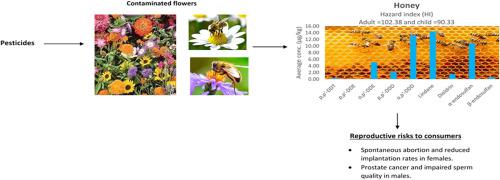Ecotoxicology and Environmental Safety ( IF 6.8 ) Pub Date : 2021-03-04 , DOI: 10.1016/j.ecoenv.2021.112094 Stuart Ben Mukiibi , Steven Allan Nyanzi , Justus Kwetegyeka , Chijioke Olisah , Adewale Matthew Taiwo , Edward Mubiru , Emmanuel Tebandeke , Henry Matovu , Silver Odongo , Juma John Moses Abayi , Emily Chelangat Ngeno , Mika Sillanpää , Patrick Ssebugere

|
Honey has multifaceted nutritional and medicinal values; however, its quality is hinged on the floral origin of the nectar. Taking advantage of the large areas that they cover; honeybees are often used as bioindicators of environmental contamination. The focus of the present paper was to examine the quality of honey from within the vicinity of an abandoned pesticide store in Masindi District in western Uganda. Surficial soils (< 20 cm depths) and honey samples were collected from within the vicinity of the abandoned pesticide store and analysed for organochlorine pesticide (OCP) residues using gas chromatograph coupled to an electron capture detector (GC-ECD). The mean level of ∑DDTs in all the soil samples was 503.6 µg/kg dry weight (d.w). ∑DDTs contributed 92.2% to the ∑OCPs contamination loads in the soil samples, and others (lindane, aldrin, dieldrin, and endosulfans) contributed only 7.8%. Ratio (p, p′-DDE + p, p′-DDD)/p, p′-DDT of 1.54 suggested historical DDT input in the area. In all the honey samples, the mean level of ∑DDTs was 20.9 µg/kg. ∑DDTs contributed 43.3% to ∑OCPs contamination loads in the honey samples, followed by lindane (29.8%), endosulfans (23.6%) and dieldrin (3.2%), with corresponding mean levels of 14.4, 11.4 and 1.55 µg/kg, respectively. Reproductive risk assessment was done based on the hazard quotient (HQ) and hazard index (HI) procedure. In our study, the calculated HIs for adults (102.38), and children (90.33) suggested high potential health risks to the honey consumers. Lindane, endosulfan and p, p′-DDD detected in the honey samples at levels exceeding the acute reference dose (ARfD) are known risk factors for spontaneous abortion, reduced implantation, menstrual cycle shortening, impaired semen quality, and prostate cancer in exposed individuals and experimental animal models.
中文翻译:

乌干达蜂蜜中的有机氯农药残留物是对消费者的环境污染和生殖健康影响的生物指标
蜂蜜具有多种营养价值和药用价值。但是,其质量取决于花蜜的花香起源。利用它们所覆盖的大面积区域;蜜蜂经常被用作环境污染的生物指标。本文的重点是检查乌干达西部马辛迪区一家废弃农药仓库附近蜂蜜的质量。表土(< 从废弃农药仓库附近收集20厘米深的蜂蜜样品),并使用与电子捕获检测器(GC-ECD)相连的气相色谱仪分析有机氯农药(OCP)残留量。所有土壤样品中∑DDT的平均水平为503.6 µg / kg干重(dw)。∑DDT对土壤样品中∑OCPs污染负荷的贡献为92.2%,而其他(林丹,艾氏剂,狄氏剂和硫丹)的贡献仅为7.8%。比率(p,p'-DDE + p,p'-DDT)/ p,p'-DDT为1.54,表明该区域有历史DDT输入。在所有蜂蜜样品中,ΣDDT的平均含量为20.9 µg / kg。∑DDT对蜂蜜样品中∑OCPs的污染负荷贡献了43.3%,其次是林丹(29.8%),硫丹(23.6%)和狄氏剂(3.2%),相应的平均水平分别为14.4、11.4和1.55 µg / kg。 。生殖风险评估是根据危害商(HQ)和危害指数(HI)程序进行的。在我们的研究中,成人(102.38)和儿童(90.33)的计算出的HIs对蜂蜜消费者提出了很高的健康隐患。蜂蜜样品中检测到的林丹,硫丹和p,p'-DDD含量超过急性参考剂量(ARfD),是自发流产,着床减少,月经周期缩短,精液质量受损,


























 京公网安备 11010802027423号
京公网安备 11010802027423号